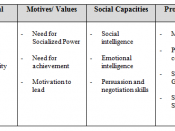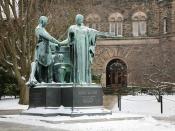According to the e-text, Management Theory, Practice and Application, there are four main types of leadership theories. The trait theory is the idea that leaders are characterized by certain traits which are present at birth. Early researchers believed that by studying the personality and intelligence of such leaders, they could create the combination of traits that makes a great leader. Early research was inconclusive, but it did reveal the traits that make a person an extraordinary leader. Those traits include drive, desire to lead, honesty and integrity, self-confidence, cognitive ability, and knowledge of business. Not all traits are used at the same time or for all situations.
Fred Fiedler, a psychologist at the University of Illinois, tried to determine if the leniency of a leader had an affect on the production of the employees. The study was inconclusive to determine if being lenient had an affect. According to Fiedler's Contingency Theory, there are three situational factors that contribute to determine if the leader is a least preferred co-worker.
High LPC means the leader is people oriented, while Low LPC means the leader is more task oriented. The situational factors are position power, task structure, and leader-member relations. The usefulness of this theory remains in dispute even today.
Leader-member exchange is another type of leadership theory. This is the theory that deals with the way leaders treat subordinates. Most people have noticed that all subordinates are not treated equally. The theory states that leaders tend to divide their subordinates into an "in" group and an "out" group. Some of the characteristics of what determines which group you fall into are similarities in gender, age, or attitudes. The quality of the leader-member exchange or relationship was based on two things: similarity of the leader and follower extroversion. The findings...


